MAYPOP & ASPARAGUS, BEAUTIFUL & EDIBLE
Awesome, Made More So
You would think — or I, at least, would think — that a purple and white passionflower would be more passion-inducing than one that was merely white. Not so. The white one displays a passionate juxtaposition between a pure, lily-whiteness and a wildness from the the squiggly, threadlxike rays of its corona backdropping female stigmas’ that arch over the yellow pollen-dusted anthers.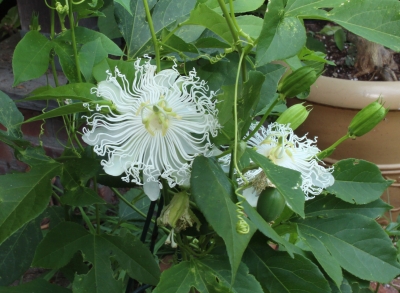
A white passionflower is a rarity. Mine sprung up by chance from a batch of seeds I planted last year. Mostly the plants bear purple and white flowers.
Most passionflowers are tropical, but this white-flowered passionflower, like its mother and siblings can survive outdoors even with our winter lows of well below zero degrees Fahrenheit. Commonly known as maypop, Passiflora incarnata is native to eastern U.S. as far north as Pennsylvania. Tropical passionflowers, are woody perennial vines; maypop is an herbaceous perennial vine, dying back to the ground each fall, but sprouting each spring from its perennial roots.
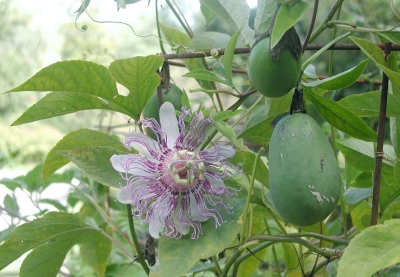 Vine growth begins late, typically not showing until early June here in the Hudson Valley. Summer warmth coaxes it along to begin flowering in July. Once the flowers appear, they continue almost nonstop through the summer until fall, with one to a few new flowers opening each day.
Vine growth begins late, typically not showing until early June here in the Hudson Valley. Summer warmth coaxes it along to begin flowering in July. Once the flowers appear, they continue almost nonstop through the summer until fall, with one to a few new flowers opening each day.
Fruits soon follow the flowers. Yes: Fruits! Passionfruits are delicious, and maypop fruits taste pretty much the same as tropical passionfruits — the main flavor in Hawaiian punch, in case you think you’re unfamiliar with the fruit. The fruit is egg-shaped, its interior packed full of seeds, each of which is surrounded by a thick coat of deliciousness, in much the same way as pomegranate seeds.
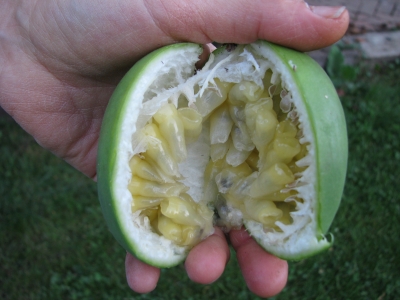 I haven’t figured out where to plant my maypops, so they’re still in large pots. Years ago, I had a couple in the ground at the base of a lilac tree. The maypops climbed into the lilac to put on a show through summer, after the lilac itself was no longer interesting. Now I want a fence for it to clothe in a heat-capturing spot in full sunlight. Maypop does spread underground, to the extent that it’s considered a weed in the Deep South, where it really can run wild. Spread is less here, but still, I need a location for it that takes that potential into account. Alternatively, I’ll plant it in a deep, bottomless container, such as a chimney flue.
I haven’t figured out where to plant my maypops, so they’re still in large pots. Years ago, I had a couple in the ground at the base of a lilac tree. The maypops climbed into the lilac to put on a show through summer, after the lilac itself was no longer interesting. Now I want a fence for it to clothe in a heat-capturing spot in full sunlight. Maypop does spread underground, to the extent that it’s considered a weed in the Deep South, where it really can run wild. Spread is less here, but still, I need a location for it that takes that potential into account. Alternatively, I’ll plant it in a deep, bottomless container, such as a chimney flue.
The Other Kind of Passion
If truth be told, the “passion” that gave passionflowers their name refers to a religious passion, the passion of Christ. The plant was a seventeenth-century teaching tool for spreading the gospel.
Passionflower “had clearly been designed by the Great Creator that it might, in due time, assist in the conversion of the heathen among which it grows,” wrote a Christian scholar of the seventeenth century. The ten so-called petals (botanically, five petals and five petal-like sepals) were taken to represent the ten apostles present at the crucifixion. The threadlike rays of the corona were taken for symbols of the crown of thorns. The five stamens and three styles referred, respectively, to the five wounds of Christ and the three nails used in the crucifixion. Even the rest of the plant figures in, with the three-lobed leaves representing the Trinity and the tendrils representing the scourges. 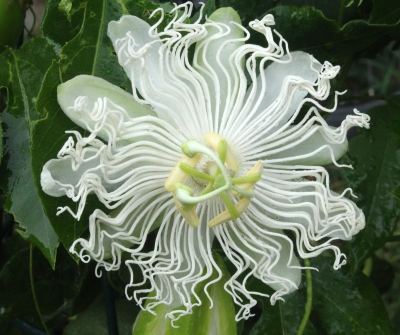
Passionflowers are heavenly enough to bring on a religious devotion to growing the plants. Which brings us to sex . . . The flowers are andromonoecious, which means that on every plant some flowers are perfect (have functioning male and female flower parts) and some are functionally male. Functional males have female parts but are functionally male either because their stigmas are held upwards out of the way of insect visitors or because their female parts are atrophied. So grow two plants if insects are to do your bidding, one plant if you’ll take care of pollination.
See my book Uncommon Fruits for Every Garden for more — a whole chapter! — on hardy passionfruits.
“Sparrowgrass” Need Help
My asparagus is now a six-foot-high, ferny hedge outside and along the eastern edge of one of the vegetable gardens. It’s a pretty sight until my eyes drop downward to see the weeds sprouting at the “hedge’s” feet. Not that the weeds are putting the brakes on the asparagus, but they are making seeds that then spread into the vegetable garden.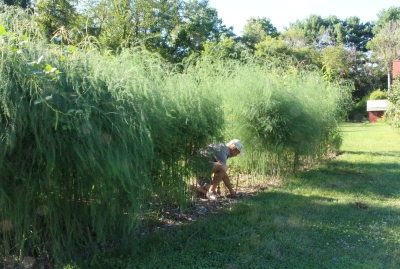
I’ve seen gardens and farms where asparagus beds were abandoned because of weeds. Mulching and early season weeding only go so far.
The usual recommendation for growing asparagus is to purchase roots and plant them at the bottom of a deep trench. As new shoots grow, the trench is gradually filled in with soil.
More recent research showed that such heroic efforts were unnecessary. I planted my asparagus just deep enough to get them into the ground.
The reason for trenching asparagus was to get the crowns low enough so that a tiller or hoe could be used to kill weeds without damaging the crown. All of which is impossible when the crowns are planted with their buds just beneath the surface.
So these days I’m periodically crawling into the hedge, becoming very intimate with the ground there, and pulling out all the weeds.


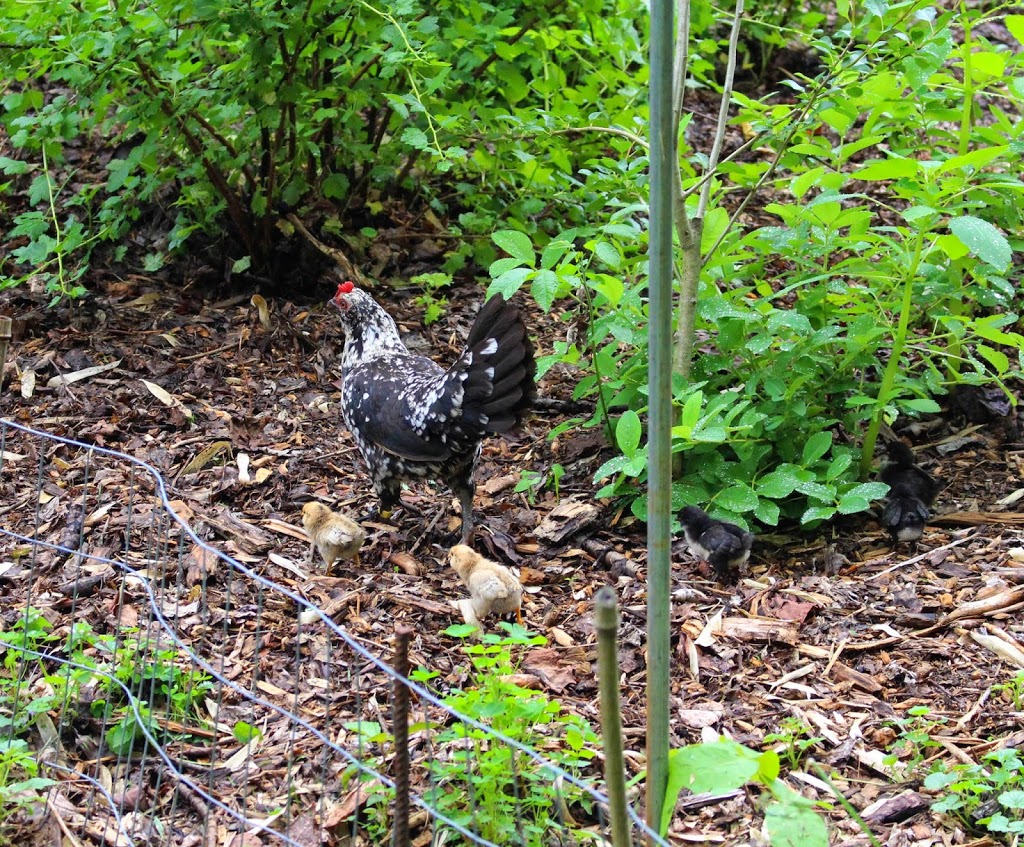
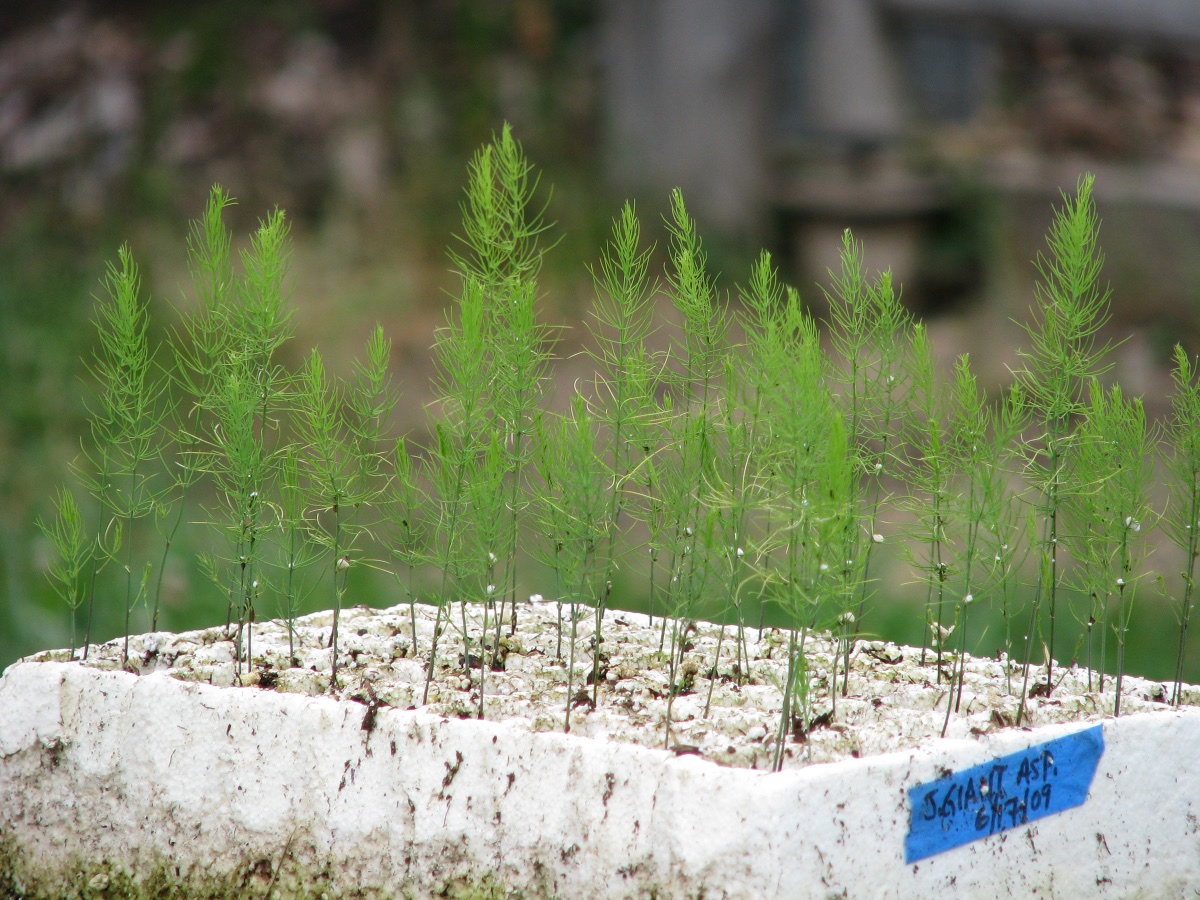

Where can I get seed for this vine?…or a start?
One source is Raintree Nursery, for which there is a link on the banner ad on my blog site.
Are maypops edible? I have passionfruit that is green on the outside and looks just like your photos
Yes, very edible, like passionfruit, which it is a species of. Harvest when the fruit detaches easily or has dropped.
I just finded some in some woods.
My question is what part is edible?
With maypop, the ripe fruit is edible and delicious. Its the flavorful pulp around the seeds inside the fruit. (You can eat the seeds.)
I grew Passion vine for the first time this year! It has wowed me nearly everyday and I have little fruits! I must see what they look like inside – not familiar with eating. I grew a variety called Betty Myles Young in a large pot just outside my porch window so I could ogle over every flower. I ordered the vine (start) from Easy-to-grow bulbs. I must say I am very happy with the purchase. I tried some seed before and I believe I read it takes up to 3 months to germinate. The cost of the vine seemed minimal and the results were and still are spectacular. I hope to overwinter it in my cellar as it is hardy to Z6! I love the white! My asparagus is most likely covered in weeds – I am afraid to venture out there – it has been too hot for me to work in my own garden (on top of my gardening job). I think I sweat at least twenty buckets this summer – I’m done. Looking forward to frost!
Maypop/Passion vine grow wild here in South Carolina, I have to pull them out of my
asparagus. My asparagus never get over 40 inches tall, but they are strong producer
every year. Your asparagus likes like sea grass.
I adore my wild passionflowers/maypop. I like to make tropical-tasting sorbets and juices with the fruit and put the leaves and flowers in teas for a sleeping aid.
It is difficult to keep them in one area, here in Indiana, since they do spread underground; but one particular year there were a plethora growing and covered my arbor leading into the herb garden. What a glorious sight indeed!! Thank you for the post. Enjoy your blog very much.
When should I plant the passionflower seeds, please? I have already bought them, but I am not sure when I should put them in the soil. I am very not knowledgeable in gardening.
Thank you for your help.
Good question. I’m planting mine in seedling flats in the greenhouse in the next couple of weeks. Temperatures in there get down to the 30s at night; sunny days it’s warm in there. If planting outdoors, it depends on where you are. I’d guess to plant them about when you’d plant peas or other first crops of the season.
Hi I have a white may pop exactly as pictured. My question is that fruit itself does it contain a lot of pulp? The fruits that I have are dry and very little pulp. It’s not comparable to the purple passionfruits with the orange flesh inside. I’m just wondering if it’s my soil or the fruit itself. Thank you.
The inside of most maypops — passionfruits in general, I think — is mostly air. The “pulp” is the gelatinous coating around each seed.
i find they need a good watering routine when they are fruiting also i dont fertilize them when they start flowering
Lee, I don’t know if you will see this in this old thread. But I purchased some maypop starts earlier this year, and planted them in a pot since I thought I would be moved by now. We aren’t moving until next May. I am in NE ohio (north canton), and don’t know how to keep them over winter. Should I plant them in the ground, or move them in the small pot (only 5″ deep and round) into a non heated garage. Things freeze in that unattached garage, I don’t want them to die. thank you!-Donna
I would pot them up and then sink the pots into the ground up to their rims. Then mulch.
Hi Lee- I’m in Milwaukee Wisconsin zone 5, just bought a passiflora incarnata start. Wondering where I should plant in my small fenced in backyard I don’t want it to spread out of control, but would love for it to climb the fence, garage or house. Should I sink a pot underground? What size? Also, how far out would you say the plant grows from what it’s climbing? Thanks!!!
It can eventually grow a couple of feet. Of course, if a sprout develops that far, the roots and plants can spread another couple of feet. I like to grow it where it can be contained by lawn mower.
your white may pop is beautiful how is it doing now a couple years later?
Good
Do I need more then one plant??
According to some “experts,” including me (in my book about uncommon fruits), yes. But I have had a single plant sometimes bear some fruits. Who’s right? Me or me?